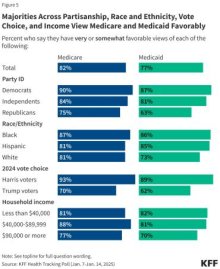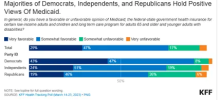Medicaid funding is crucial to AFT members and the communities we serve. Access to healthcare is key for seeking and maintaining a job, but Congress is moving to cut Medicaid funding by hundreds of billions of dollars. 13.7 million people could lose their Medicaid or Affordable Care Act coverage under the plan being pushed through Congress.
This plan includes reporting requirements that would likely strip coverage from hundreds of thousands of children, cost up to 449,000 jobs, and lead to more than 15,400 avoidable deaths each year. See how your state could be impacted.
Take Action
- Write a Letter to Congress: Hands off Medicaid!
- Call Your Representative: No cuts to Medicaid!
- Write a letter to the editor: Draft Letter for Healthcare Professionals
- Write a letter to the editor: Draft Letter for Educators
Cuts to Medicaid will impact schools and hospitals and public services.
Schools
State Medicaid programs—and federal contributions to Medicaid, which cover at least half of spending—have been instrumental in ensuring consistent financing. Since 1988, Medicaid dollars in schools have supported:
- Salaries for health professionals, such as speech pathologists, occupational therapists and school nurses;
- High-quality physical and mental health services such as targeted case management, health education, cognitive behavioral therapy, catheterization, audiology and physical therapy;
- Medical transportation for select students with individual education programs;
- Equipment, including wheelchairs, lifts and therapeutic bicycles; and
- Program administration, which can include helping eligible families enroll and even translations for diverse populations.
Click here (and scroll down) to see the percentage of students supported by Medicaid/CHIP in your school district
Hospitals
Hospitals rely on Medicaid payments to stay open and adequately staffed. Funding cuts to hospitals are likely to lead to staffing cuts, putting patients in unnecessary danger, closing essential services, and devastating communities. We break down how this will happen in our analysis here.
Medicaid spent $262.6 billion on hospital care in 2022. Hospital spending accounted for 33 percent of total Medicaid spending and Medicaid payments to hospitals accounted for 19 percent of all payments to hospitals in 2022.
Medicaid Disproportionate Share Hospital funding helps to keep safety-net hospitals open. AFT members are currently fighting to keep SUNY Downstate open.
Click here to see how many people use Medicaid and the Children’s Health Insurance Program in your Congressional district: https://ccf.georgetown.edu/2024/12/04/medicaid-chip-coverage-by-congressional-district-2023/
Public Employees and Higher Education
Medicaid provides more than half of federal funding to states. If we don't take action to protect this program, states will have to make cuts - law enforcement, higher education, and other public services could be slashed. To make matters worse, we estimate that for every dollar cut to Medicaid, there is $1.70 in lost economic activity, which will further reduce state revenue.
Retirees
AARP states that "Medicaid is the nation’s largest payer for long-term care (LTC), which include hands-on assistance with basic tasks such as feeding, bathing, and dressing. Medicaid LTC enrollees are often older adults with serious and often complex care needs, including Alzheimer’s and other dementias. Having Medicaid can be the reason an older adult can get out of bed, get dressed, and go about their day. Medicaid program dollars have been shown to provide stability in the health care system, particularly in lowering rates of rural hospital closures. Medicaid’s direct support for health care and LTC access and reliable reimbursement rates for hospitals and providers also indirectly support surrounding local economies supporting employment and financial stability. More than 2.7 million Medicaid-enrolled adults ages 50 and older live in rural areas."
The cuts proposed by the House of Representatives may impact you even if you plan to enroll in Medicare:
- Medicaid covers premiums for 1 in 6 Medicare enrollees.
- Medicaid covers Medicare’s co-insurance, co-pays, and deductibles, for 8 million Medicare enrollees.
- While Medicare covers short-term skilled nursing facility stays following a hospitalization, Medicaid covers the majority of long-term stays.
- Medicaid also covers critical services that Medicare does not, such as transportation to medical appointments, medical equipment like mobilized wheelchairs, dental, vision, and hearing benefits, and some treatment options for substance use disorder.
Take a look at how people in your state could be hurt by Medicaid cuts.
Don’t believe the lies about Medicaid being a handout.
This is a fight we can win. Regardless of politics, people support Medicaid.


Fact sheets
Take action
- E-action to share online: Tell Congress-Hands Off Medicaid!
- Share these videos online:
- The Rich or the Rest of Us?
With healthcare costs soaring, millions of Americans-including veterans, seniors, and kids with disabilities-are at risk of losing their healthcare if Congress cuts Medicaid. It's time to hold Congress accountable. Ask your representative: Are they on the side of the rich or the rest of us? Visit: https://actionnetwork.org/letters/medicaid-cuts-2025/
- Did You Hear?
Congress is pushing for massive tax cuts for billionaires-but at what cost? Medicaid, which provides healthcare to two in five American children and millions of working adults, is in the crosshairs. Cutting Medicaid would leave a gaping hole in state budgets, impacting essential services like education, emergency responders, and infrastructure. Tell Congress to reject Medicaid cuts. Visit: https://actionnetwork.org/letters/medicaid-cuts-2025/
- AFT Member Update: Medicaid Cuts
Congress is attempting to cut Medicaid to fund Trump's tax cuts, and the consequences will be severe. The most vulnerable populations, including children, pregnant women, the elderly, and those with disabilities, will lose vital healthcare access. Hospitals may close or cut jobs. We need you to speak up for your students and patients.
Visit: https://actionnetwork.org/letters/medicaid-cuts-2025/
- Essential Services or Billionaires?
Congress is pushing Medicaid cuts that will force states to slash vital services like police, firefighters, and teachers. Nearly 39% of children could lose healthcare, and rural hospitals may close. All for billionaire tax breaks. Tell your Congress member to stand with us, not the rich. Visit: https://actionnetwork.org/letters/medicaid-cuts-2025/
- The Rich or the Rest of Us?
Share these graphics:
- The real cost of cuts to Medicaid: 449,000 jobs may be lost.
- The real cost of cuts to Medicaid: Hundreds of thousands of children could be stripped of coverage.
- The real cost of cuts to Medicaid: 15,400 avoidable deaths might occur every year.
- More emergencies, less staff = Tragedy
- Nearly 7 in 10 school districts rely on Medicaid reimbursements
- Medicaid is the largest health insurance provider for children
- Medicaid helps 72 million people with disabilities, veterans, new mothers, retirees, students, and low wage workers.
- Medicaid provides the largest federal contribution to states.
Budget
Additional Reading
In the News
- Medicaid cuts projected to eliminate health insurance coverage for millions
- See how many people could lose coverage under one proposal
- See the number of people who could lose healthcare under another proposal
- How Medicaid cuts threaten rural healthcare
- Montana teachers concerned over looming federal Medicaid cuts
- Medicaid cuts could threaten schools supports in NJ
- Medicaid cuts in Ohio: Who would pay the price?
- The Public’s Views on Potential Changes to Medicaid
- AARP says no to Medicaid cuts
- Undeniable connections
- Catholics call on Congress to protect Medicaid
- Concerns mount over potential loss of Medicaid funds for schools
- Medicaid cuts could hurt low-income Alaskans, damage health care system
- 71 percent of Trump voters oppose Medicaid cuts: Poll
- Nurse practitioner: Medicaid cuts could 'devastate' WA patients, providers
- Nurse: NYS hospitals would be harmed by proposed Medicaid cuts
- CA schools brace for harmful cuts to Medi-Cal
